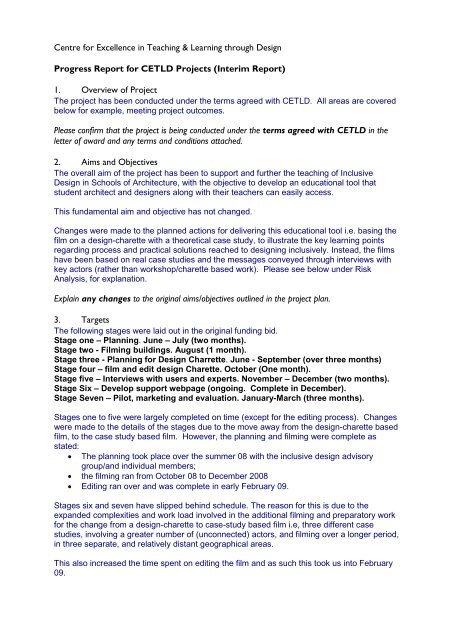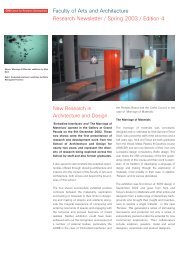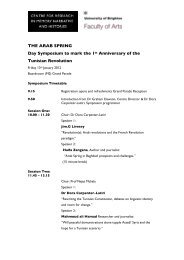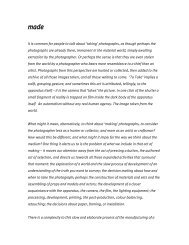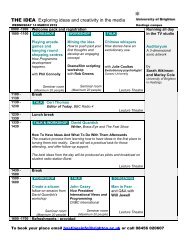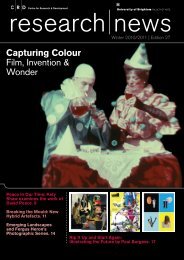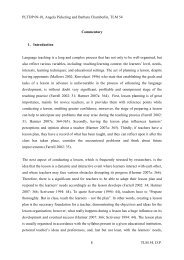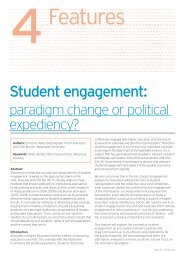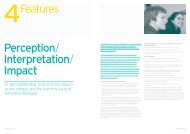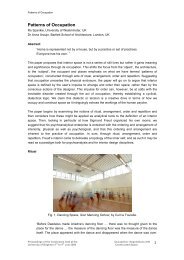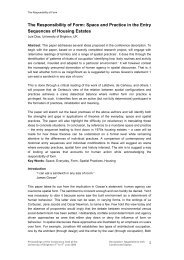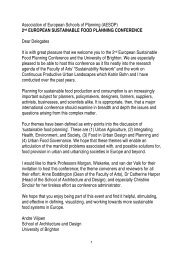Interim Report - University of Brighton - Faculty of Arts
Interim Report - University of Brighton - Faculty of Arts
Interim Report - University of Brighton - Faculty of Arts
You also want an ePaper? Increase the reach of your titles
YUMPU automatically turns print PDFs into web optimized ePapers that Google loves.
Centre for Excellence in Teaching & Learning through Design<br />
Progress <strong>Report</strong> for CETLD Projects (<strong>Interim</strong> <strong>Report</strong>)<br />
1. Overview <strong>of</strong> Project<br />
The project has been conducted under the terms agreed with CETLD. All areas are covered<br />
below for example, meeting project outcomes.<br />
Please confirm that the project is being conducted under the terms agreed with CETLD in the<br />
letter <strong>of</strong> award and any terms and conditions attached.<br />
2. Aims and Objectives<br />
The overall aim <strong>of</strong> the project has been to support and further the teaching <strong>of</strong> Inclusive<br />
Design in Schools <strong>of</strong> Architecture, with the objective to develop an educational tool that<br />
student architect and designers along with their teachers can easily access.<br />
This fundamental aim and objective has not changed.<br />
Changes were made to the planned actions for delivering this educational tool i.e. basing the<br />
film on a design-charette with a theoretical case study, to illustrate the key learning points<br />
regarding process and practical solutions reached to designing inclusively. Instead, the films<br />
have been based on real case studies and the messages conveyed through interviews with<br />
key actors (rather than workshop/charette based work). Please see below under Risk<br />
Analysis, for explanation.<br />
Explain any changes to the original aims/objectives outlined in the project plan.<br />
3. Targets<br />
The following stages were laid out in the original funding bid.<br />
Stage one – Planning. June – July (two months).<br />
Stage two - Filming buildings. August (1 month).<br />
Stage three - Planning for Design Charrette. June - September (over three months)<br />
Stage four – film and edit design Charette. October (One month).<br />
Stage five – Interviews with users and experts. November – December (two months).<br />
Stage Six – Develop support webpage (ongoing. Complete in December).<br />
Stage Seven – Pilot, marketing and evaluation. January-March (three months).<br />
Stages one to five were largely completed on time (except for the editing process). Changes<br />
were made to the details <strong>of</strong> the stages due to the move away from the design-charette based<br />
film, to the case study based film. However, the planning and filming were complete as<br />
stated:<br />
• The planning took place over the summer 08 with the inclusive design advisory<br />
group/and individual members;<br />
• the filming ran from October 08 to December 2008<br />
• Editing ran over and was complete in early February 09.<br />
Stages six and seven have slipped behind schedule. The reason for this is due to the<br />
expanded complexities and work load involved in the additional filming and preparatory work<br />
for the change from a design-charette to case-study based film i.e, three different case<br />
studies, involving a greater number <strong>of</strong> (unconnected) actors, and filming over a longer period,<br />
in three separate, and relatively distant geographical areas.<br />
This also increased the time spent on editing the film and as such this took us into February<br />
09.
Stage six is now being carried out in March and April 09, with stage six planned for end in<br />
June 2009.<br />
A further stage, relating solely to dissemination, will be ongoing throughout the year and<br />
2010.<br />
State whether the targets set for this reporting period have been met, and the reasons for any<br />
delays.<br />
4. Project Outputs<br />
To date the following outputs have been achieved.<br />
• Filming complete (three venues making up the film; all actors involved in the venue i.e<br />
architects/designers; access consultants; access group members; clients; narrators).<br />
(Jan 09)<br />
• Editing complete (Feb 09)<br />
• Film launch complete – internal RIBA promotional event to key stakeholders and<br />
press. (Feb 09)<br />
• Film available online at Youtube (access from www.architecture.com and as DVD<br />
format pending) (Mar 09)<br />
Summarise progress during the reporting period and milestone/ deliverables achieved.<br />
5. Project Outcomes<br />
Below is the list <strong>of</strong> outcomes as stated in the funding bid to CETLD. An analysis <strong>of</strong><br />
achievement to date is provided for each.<br />
i) Develop an audio-visual online tool to aid the teaching <strong>of</strong> inclusive design amongst<br />
higher education design and architectural students.<br />
The production <strong>of</strong> the film is complete, is publically accessible and is already being used by<br />
teachers <strong>of</strong> higher education. Supplementary tools to assist with the use <strong>of</strong> this film are<br />
currently being written and will be available (end April 09).<br />
ii) Enable an understanding and teaching <strong>of</strong> inclusive design as a core element <strong>of</strong> the<br />
design process that is based on a more comprehensive understanding <strong>of</strong> the key<br />
issues than the current educational and regulatory focus on accessibility, legislation<br />
and disability.<br />
The level <strong>of</strong> understanding reached will be assessed as part <strong>of</strong> the evaluation process<br />
(please see below).<br />
The film successfully depicts a broader element <strong>of</strong> Inclusive Design that goes beyond a<br />
narrow focus <strong>of</strong> accessibility covered by legislation and the more common and shallow<br />
understanding <strong>of</strong> mobility aspects <strong>of</strong> access.<br />
The film (over the three case studies featured) discusses Inclusive Design as an ongoing<br />
process from the outset that has at its core the process <strong>of</strong> meaningful engagement <strong>of</strong> users<br />
with a wide range <strong>of</strong> experiences and relevant expertise.<br />
It also provides a number <strong>of</strong> practical examples <strong>of</strong> Inclusive Design that cover the subject in<br />
a wider breadth:<br />
• Designing to accommodate Somali pupils and their religious and cultural<br />
requirements.<br />
• Designing for older people who as a population have increased disability<br />
requirements.
• Design solutions to accommodate disabled people with a wide range <strong>of</strong> requirements<br />
– arthritic, wheelchair users/mobility impaired; visually impaired; dwarfism; learning<br />
difficulties.<br />
• The need to accommodate for parents with children (push chairs, fatigue).<br />
• Inclusive Design as about psychological as well as physical access e.g. Children and<br />
staff facing a new school environment, involved and communicated throughout the<br />
process <strong>of</strong> design and construction to prepare them for the change.<br />
• Teachers (in particular female teachers) needing good geographical access to toilets<br />
during their working day<br />
iii) Create a virtual space for inclusive design education that can be used and further<br />
developed by students and pr<strong>of</strong>essionals alike.<br />
The film is posted onto Youtube. This site enables students and teachers to publically<br />
comment on the film, share and post links. The films are also broken up into chapters, for<br />
the sole reason that students and teachers will be able to pick and choose clips at their<br />
discretion. E.g. teachers leading a seminar session wanting to examine only at the process<br />
<strong>of</strong> consultation would be able to take different clips from each film on this theme without<br />
watching them in its entirety.<br />
iv) Create an educational tool for students that can also be used as Continuing<br />
Pr<strong>of</strong>essional Development (CPD) material for practicing pr<strong>of</strong>essionals.<br />
The tool is being marketed as having wider applicability to practicing architects/designers,<br />
clients, planners and others involved in the built environment. In particular the use <strong>of</strong> the film<br />
as a fun and easy CPD session.<br />
RIBA CPD colleagues are including the film in their CPD workshops and regional tours. We<br />
have a number <strong>of</strong> practising architects who report to have already included it their internal<br />
CPD sessions.<br />
v) Challenge negative attitudes <strong>of</strong> inclusion and address ignorance by capturing and<br />
illuminating the experiences and needs <strong>of</strong> different users in different circumstances –<br />
such as those with varied disabilities, women/men with children, those with religious<br />
requirements and so on.<br />
Please see the list under point ii) above. Those interviewed on the films provide viewers with<br />
their understating <strong>of</strong> Inclusive Design being about accommodating for needs and<br />
experiences on a wide scale – including disabled, older people, younger people, local<br />
community, staff, women, parents and Muslim students.<br />
Also, users and access consultants interviewed in the films challenge the viewer to overcome<br />
any fears with consultation regarding the design process, and even touch on some<br />
designers’ apparent and incorrect self-belief in understanding all issues <strong>of</strong> inclusive design<br />
without the need to engage with users.<br />
vi) Demonstrate the differing and creative nature <strong>of</strong> designing for inclusion by showing<br />
and debating different design solutions from existing buildings.<br />
The three projects featured in the film are different from one another with different functions,<br />
locations and design teams:<br />
1. The Roundhouse in London, a Grade II Listed building, refurbished as a public <strong>Arts</strong><br />
venue.<br />
2. The Eden Project, in Cornwall, a well known, large-scale and complex visitor<br />
attraction.
3. The Willows, in Wolverhampton, a new school under construction, that will bring<br />
together the population <strong>of</strong> a primary school, a special needs school, and a community<br />
facility on one integrated site.<br />
As a result, while there are many similar design solutions reached across all e.g. signage,<br />
engraved banisters, seating, there are many unique design solutions. For example, the<br />
school with curved walls for autistic children; the land train and concert viewing platform at<br />
Eden; the coloured gradient wall in the circular foundation level <strong>of</strong> the Roundhouse. All<br />
design solutions are reasoned with clear logic by those providing the information on film.<br />
vii) Bring about a positive dynamic where the sister disciplines <strong>of</strong> architecture, interior<br />
and landscape design can bring particular focus on multi-sensory and ergonomic<br />
aspects <strong>of</strong> design (visual, sound, tactile and even smell in the case <strong>of</strong> landscape<br />
architecture in particular).<br />
Two <strong>of</strong> the films feature the architect as the main designer (although taking advice from<br />
artists, when working on interior way-finding and signage). The third film, featuring Eden,<br />
shows the involvement <strong>of</strong> the landscape architect and the crucial role played in the design <strong>of</strong><br />
the gardens in providing experiences that do not rely on sight, such as the smell <strong>of</strong> different<br />
plants, and the feel <strong>of</strong> sculptures and ceramics. The important role that landscape design<br />
can play is also shown in the way it is used here to create level access for those in<br />
wheelchairs to all floors <strong>of</strong> the education centre.<br />
viii) Reach a wider range <strong>of</strong> students needing to have a good understanding by<br />
dissemination materials via the RIBA-based portal to all architecture schools and<br />
RIBA regional <strong>of</strong>fices<br />
This has already begun with the link to the film being sent out widely via RIBA channels –<br />
RIBA member newsletters; online RIBA forums; RIBA staff; presentations to RIBA staff<br />
responsible for regional work and CPD.<br />
A programme <strong>of</strong> dissemination is being planned for all architecture schools with DVDs to be<br />
sent; visits by project lead to present to staff; and RIBA Education department including a<br />
film viewing at their architecture school tour beginning October 09 to staff and students.<br />
Summarise achievement against objectives, list outcomes and findings to date and any interim<br />
conclusions.<br />
6. Stakeholders<br />
A range <strong>of</strong> stakeholders have been engaged. The key target group are students and<br />
teachers, and engagement with them will form the next stage <strong>of</strong> dissemination. However,<br />
there has been initial (unstructured in terms <strong>of</strong> questioning) contact with students and<br />
teachers to date:<br />
• Part II students who were based at two architects firms were consulted on prior to the<br />
film being made, for confirmation that a video tool on this subject would be <strong>of</strong> interest<br />
and assistance; and that once the draft film was complete, on whether any changes<br />
needed to be made to ensure the messages were better conveyed, if there were any<br />
glaring omissions and their thoughts on value added the film brings to their learning.<br />
• Ad hoc groups <strong>of</strong> academics have been engaged with, including presentation to those<br />
from Belgrade university who will be using the film for their work<br />
Other stakeholders engaged to date. Engagement defined as viewing <strong>of</strong> film(s) and<br />
dissemination <strong>of</strong> information to access the film, and/or accompanying oral presentation<br />
defining the project.<br />
• Key policy pr<strong>of</strong>essionals (including architects) in built environment sector-related<br />
organisations, for example the Commission for Architecture and the Built
Environment, Centre for Accessible Environments, Department for Communities and<br />
Local Government.<br />
• RIBA regional staff and membership committees<br />
• RIBA CPD staff<br />
• Access consultants<br />
Summarise the project's engagement with stakeholders.<br />
7. Risk Analysis<br />
A problem was identified very early on with regards to using a design-charette (workshop),<br />
for the basis <strong>of</strong> the film. The problems were that filming <strong>of</strong> a workshop based discussion is<br />
difficult and costly and to capture it successfully, it needs:<br />
• numerous sound and camera staff.<br />
• Staged conversations to re-capture points and arguments made.<br />
As a result, due to budget and quality, it was decided to interview separate actors involved in<br />
three case studies that although hard work, was possible by one camera staff member and<br />
lay help (i.e. RIBA project coordinator).<br />
Additional difficulties that arose, related to those available to interview for the film. While<br />
many were available, the breadth that we wanted for the film meant that there were likely to<br />
be some difficulties – clients, architects, other designers, user groups (children, access group<br />
members, staff etc). The access group members were harder to reach due to groups being<br />
disbanded since the project and private commitments on time. However, this was not a major<br />
difficulty and where there were missing voices, we worked to compensate by providing a<br />
balance across the entirety <strong>of</strong> the projects.<br />
Roundhouse – access group members, access consultant and client emphasis (less<br />
emphasis on designer).<br />
Willow School – Architect and client emphasis (access group member voice missing.<br />
Although other users e.g. school children featured).<br />
Eden project – Access group members, access consultant and designer (less emphasis on<br />
client).<br />
A difficulty arose in the partner relationship with one partner, but that require any mitigating<br />
action (please see under Project Management).<br />
Summarise any problems that have occurred and any mitigating action taken.<br />
8. Intellectual Property Rights<br />
N/A<br />
Summarise progress clearing any third-party rights.<br />
9. Project Management<br />
A change to the partner group occurred as a result <strong>of</strong> one partner (Jos boys, <strong>University</strong> <strong>of</strong><br />
<strong>Brighton</strong>), withdrawing from the project on the basis <strong>of</strong> a theoretical disagreement with the<br />
first draft <strong>of</strong> the first film. This related to the lack <strong>of</strong> disabled user voices on The Willows<br />
School project.<br />
However, this did not significantly affect project timings.<br />
Note any changes in project staff or their roles since the beginning <strong>of</strong> the project. Explain<br />
briefly any problems or gaps with staffing and the effect this has had on the project schedule.
10. Budget<br />
Expenditure has changed with regards to film director/camera staff, due to change from<br />
workshop based to project based film. The amount rose significantly from the estimated £2,<br />
900 to £10,263.00. his will rise again for two days for additional days <strong>of</strong> filming and editing.<br />
However, the cost has been recovered by that estimated from the charette. Also, those<br />
involved in the films have taken part voluntarily and expenses <strong>of</strong>fered have not been taken<br />
up.<br />
Cost to date for expert advisor, is £345.<br />
Costs for Project Coordinators expenses (travel and accommodation to Cornwall; Hereford<br />
(two trips); and Roundhouse, total £435.5<br />
Costs for the RIBA launch <strong>of</strong> film, total, £1174.<br />
A break down <strong>of</strong> all the costs can easily be supplied on request by zoe.smith@inst.riba.com<br />
Summarise expenditure to date and provide reasons for any changes from original budget plan.<br />
12. Evaluation<br />
The following stages <strong>of</strong> evaluation were outlined in the funding bid.<br />
1. Students’ experiences <strong>of</strong> the design charrette<br />
2. Reviewing the edited film against the original ‘narration’.<br />
3. An assessment <strong>of</strong> its impact on student awareness <strong>of</strong>, and learning about, inclusive design.<br />
4. Produce a project evaluation and recommendations report:<br />
Overall evaluation is aimed at testing;<br />
• Relevance <strong>of</strong> new approaches to content and methods on learning about inclusive<br />
design within architecture courses<br />
• Appropriateness <strong>of</strong> new content in support <strong>of</strong> student learning and active participation<br />
• Usability <strong>of</strong> content and structure with staff and students in different contexts<br />
• impact on student learning<br />
• Appropriateness <strong>of</strong> materials to levels <strong>of</strong> study (introductory, intermediate and<br />
advanced), to subject and to context<br />
• Generalisability <strong>of</strong> content and methods to new learning and teaching situations<br />
1. The Design charette did not go ahead and as such no first stage <strong>of</strong> student experience<br />
evaluation.<br />
2. The film has successfully followed the original narration devised by the advisory group.<br />
Essentially the different actors to outline their perspectives<br />
• client - making the business case<br />
• architect/designer - the moral case and process <strong>of</strong> engagement relating to the RIBA<br />
stages <strong>of</strong> design; with meaningful consultation as fundamental to this process.<br />
• Users - with a range <strong>of</strong> different needs (going beyond but including disabled); how<br />
users expect to be engaged with/listened to.<br />
Many additional points were made in the film enriching the understanding <strong>of</strong> inclusive design<br />
as being about psychological access as well as physical.<br />
3. This stage has only been addressed to date on an informal basis – see engagement with<br />
students under Stakeholders section above.<br />
The project coordinator is seeking assistance from David Gosling on taking this stage<br />
forward.
4. The project coordinator is seeking assistance from David Gosling on taking this stage<br />
forward.<br />
Note any evaluation results during the reporting period.<br />
13. Dissemination Plan<br />
To date, the dissemination <strong>of</strong> the film has been the following:<br />
1. very good press coverage in key built environment press:<br />
- video uplink on Building Design<br />
- video uplink on World Architecture News<br />
- article in the National Association <strong>of</strong> Special Education Needs magazine in June<br />
- All Together Now news site:<br />
http://www.alltogethernow.org.uk/absolutenm/?a=2112&z=5<br />
- Arbota.com: http://arbota.com/riba-launches-new-guidance-for-inclusive-design-<br />
20357/<br />
- Interest from Irish Times and ` NBS Learning Channels<br />
- Article in the Architects Journal<br />
- Article on RIBA Education Forum<br />
2. An email with the link to online access via Youtube has been sent to about 400 contacts<br />
known to the RIBA with an interest and expertise in Inclusive Design including:<br />
Academics, architects, access <strong>of</strong>ficers, built environment policy <strong>of</strong>ficers.<br />
It is also being sent out to all RIBA CPD providers and recorded attendees.<br />
3. Links are being formed with CETLD, CEBE, CABE to put on their websites<br />
4. Initial discussions have been had with CABE to fund the production <strong>of</strong> DVDs (cost price) to<br />
distribute to CABE staff and consultants.<br />
Next stage<br />
5. A large programme <strong>of</strong> dissemination will begin (on production <strong>of</strong> DVDs and accompanying<br />
guidance (end April 09)) to:<br />
- sending DVD and information as hard copy post to all HE schools <strong>of</strong> architecture and<br />
design in the UK<br />
- sending web link to all HE schools <strong>of</strong> architecture and design in the UK<br />
- RIBA coordinator to visit all schools over course <strong>of</strong> 2009 and 2010 to present to staff<br />
(primarily) and students.<br />
6. A one day seminar for CETLD partners and students <strong>of</strong> UoB needs to be arranged.<br />
<strong>Report</strong> progress against plan, noting dissemination carried out, whether it was successful in<br />
your view and any publicity the project has received during the reporting period.<br />
14. Unexpected findings<br />
There have not been unexpected findings to date. However, there has been more active<br />
interest than anticipated (by project coordinator) from students reading about the film (before<br />
targeted dissemination) and asking for a link.
Have there been any unanticipated findings from your project to date?<br />
15. And finally . .<br />
The support has been helpful and straightforward and at this stage, I do not have<br />
suggestions for improvement.<br />
Do you have any suggestions for future CETLD projects in terms <strong>of</strong> bidding, guidelines or<br />
project support?


